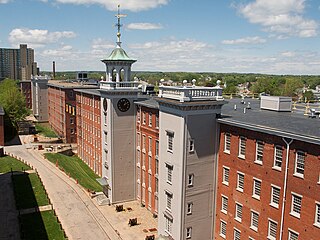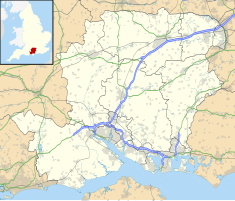History
The mill was constructed in 1800 by Henry Hayter on a plot of land called Frog Island. The mill is probably on the same site as one of the four mills recorded in the Domesday Book. Originally it was a fulling mill (part of the finishing process of cloth weaving). Some years later, in 1817, it was bought by William Madick who changed its operation to throw silk. In 1844 it was acquired by Alexander Bannerman and John Spencer, merchants of Manchester. William Chappell, the manager of the mill, purchased it from them in 1846. At this time the mill employed 108 staff, including 39 children under the age of 13. [2] By 1866 the mill had passed into the ownership of the Hide family with whom it remained until the death of James Hide in 1955. During this time, the mill wove silk for Burberry, then based in nearby Basingstoke, who used it as coloured linings for their raincoats. [3] It ultimately passed to Ede and Ravenscroft who operated it up to 1985, producing legal and academic gowns. It was then acquired by the Hampshire Buildings Preservation Trust who, after renovation works, opened it to the public in 1990. [4]
In December 2012, the Trustees recommenced silk production. [5]

Lowell National Historical Park is a National Historical Park of the United States located in Lowell, Massachusetts. Established in 1978 a few years after Lowell Heritage State Park, it is operated by the National Park Service and comprises a group of different sites in and around the city of Lowell related to the era of textile manufacturing in the city during the Industrial Revolution. In 2019, the park was included as Massachusetts' representative in the America the Beautiful Quarters series.

Quarry Bank Mill in Styal, Cheshire, England, is one of the best preserved textile factories of the Industrial Revolution. Built in 1784, the cotton mill is recorded in the National Heritage List for England as a designated Grade II* listed building. Quarry Bank Mill was established by Samuel Greg, and was notable for innovations both in machinery and also in its approach to labour relations, the latter largely as a result of the work of Greg's wife, Hannah Lightbody. The family took a somewhat paternalistic attitude toward the workers, providing medical care for all and limited education to the children, but all laboured roughly 72 hours per week until 1847 when a new law shortened the hours.

A cotton mill is a building that houses spinning or weaving machinery for the production of yarn or cloth from cotton, an important product during the Industrial Revolution in the development of the factory system.

The Darent is a Kentish tributary of the River Thames and takes the waters of the River Cray as a tributary in the tidal portion of the Darent near Crayford, as illustrated by the adjacent photograph, snapped at high tide. 'Darenth' is frequently found in the spelling of the river's name in older books and maps, Bartholomew's "Canal's and River of England" being one example. Bartholomew's Gazetteer (1954) demonstrates that Darent means "clear water" and separately explains the other name. Considering the River Darent runs on a bed of chalk and its springs rise through chalk, this is not surprising. The original purity of the water was a major reason for the development of paper and pharmaceuticals in the area.

The Society for the Protection of Ancient Buildings (SPAB) is an amenity society founded by William Morris, Philip Webb, and others in 1877 to oppose the destructive 'restoration' of ancient buildings occurring in Victorian England. "Ancient" is used here in the wider sense rather than the more usual modern sense of "pre-medieval."

Peace Dale is a village in the town of South Kingstown, Rhode Island. Together with the village of Wakefield, it is treated by the U.S. Census as a component of the census-designated place identified as Wakefield-Peacedale, Rhode Island.

Whitchurch is a town in the borough of Basingstoke and Deane in Hampshire, England. It is on the River Test, 13 miles (21 km) south of Newbury, Berkshire, 12 miles (19 km) north of Winchester, 8 miles (13 km) east of Andover and 12 miles (19 km) west of Basingstoke. Much of the town is a Conservation Area. Because of the amount of wildlife in and near the River Test, its course and banks are designated as Site of Special Scientific Interest. Whitchurch is the Gateway to the North Wessex Downs Area of Outstanding Natural Beauty (AONB); the third largest of Britain's 46 AONBs.

Stotfold is a town and civil parish in the Central Bedfordshire borough of Bedfordshire, England. The town covers 2,207 acres (8.93 km2) and the River Ivel passes through the town. The population at the 2011 census was 9,632. Stotfold is close to the county border with Hertfordshire.

The Weald and Downland Living Museum is an open-air museum in Singleton, West Sussex. The museum is a registered charity.

The Amoskeag Manufacturing Company was a textile manufacturer which founded Manchester, New Hampshire, United States. From modest beginnings it grew throughout the 19th century into the largest cotton textile plant in the world. At its peak, Amoskeag had 17,000 employees and around 30 buildings.

The Mills Archive was established in 2002 to preserve and protect records of milling heritage and to make them freely available to the public. It is governed by the Mills Archive Trust, which is a charity that is based at Watlington House, Reading, Berkshire, England.

The Junction Mills were cotton spinning and weaving mills to the west of the Portland Basin in Ashton-under-Lyne, Greater Manchester, in England. They were built between 1831 and 1890 for the Samuel Heginbottom and his sons. The firm went out of business in 1930, and all the buildings have been demolished but the 210 feet (64 m) octagonal chimney, built in 1867, and typical of that period has been preserved in situ.

Geo. Hattersley was a textile machinery manufacturer from Keighley, West Yorkshire in England, founded in 1789 and responsible for the Hattersley Standard Loom and other types of looms.

The Weavers' Triangle is an area of Burnley in Lancashire, England consisting mostly of 19th-century industrial buildings at the western side of town centre clustered around the Leeds and Liverpool Canal. The area has significant historic interest as the cotton mills and associated buildings encapsulate the social and economic development of the town and its weaving industry. From the 1980s, the area has been the focus of major redevelopment efforts.

Queen Street Mill is a former weaving mill in Harle Syke, a suburb to the north-east of Burnley, Lancashire, that is a Grade I listed building. It now operates as a museum and cafe. Currently open for public tours between April and November. Over winter the café is opened on Wednesdays. It is also viewable with private bookings.

Congleton, Macclesfield, Bollington and Stockport, England, were traditionally silk-weaving towns. Silk was woven in Cheshire from the late 1600s. The handloom weavers worked in the attic workshops in their own homes. Macclesfield was famous for silk buttons manufacture. The supply of silk from Italy was precarious and some hand throwing was done, giving way after 1732 to water-driven mills, which were established in Stockport and Macclesfield.

Many watermills lined the banks of the River Wey, England, from the 17th century due to the river's ability to provide a reliable, year-round flow of water. These mills chiefly ground wheat, often referred to as corn, for flour and oats for animal feed though many were used in the production of other goods such as paper, cloth, leather, wire and gunpowder. The river was home to more mills per mile than anywhere else in Great Britain. The mill situated at Coxes Lock near Addlestone, Surrey, is the largest. There are many mills on the river's principal tributaries, such as the Tillingbourne, the Ock and some mills on the Whitmore Vale stream, Cranleigh Waters and Hodge Brook. The last commercial mill on the Tillingbourne, Botting's Mill at Albury, closed in 1991. Headley Water Mill, on the Wey South branch is still in business. Town Mill, Guildford still has a water turbine driven generator producing electricity for the town.

The Knockando Woolmill is a historic woolmill in Moray, Scotland. Wool production has taken place at the site since at least the eighteenth century, and the surviving buildings house a number of pieces of historic machinery which are still in operation. It was designated a Category A listed building in 1995, still operates as a working mill, and is open to the public from April to September.

New Hall Mill is a watermill in Walmley, in Sutton Coldfield, West Midlands.





















